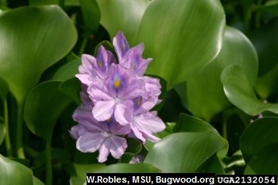Anchored water hyacinth; Water hyacinth, floating
(Eichhornia azurea); (Eichhornia crassipes)
A floating perennial herb native to South America was introduced as an ornamental in the United States in 1884. It can increase, forming dense mats that restrict light to the underwater environment.
Other names for this plant include:
- Common names: water orchid, floating water hyacinth
- Scientific names: Pontederia crassipes, Eichhornia speciosa
Classification in Wisconsin: Prohibited
Ecological Threat
- It invades freshwater lakes, reservoirs, ponds, marshes and ditches, making boating, fishing and almost all other water activities difficult.
- Degrades water quality by blocking the air-water interface and significantly reducing oxygen levels in the water, impacting underwater animals such as fish.
- Significantly reduces biological diversity: mats block sunlight, preventing the growth of submerged and emersed plant communities and also alter animal communities by blocking access to the water and lowering plants the animals depend on for shelter and nesting.
Identification
Leaves: Thick green waxy leaves, rounded, circular or elliptical with gently incurved sides. Leaves are formed in rosettes, are 6" wide, and can rise 1-3 feet above the water.
Flowers: Lavender blue with a yellow blotch. Flowers have six petals and are 2 inches wide.
Fruits & seeds: Three-celled capsules with many seeds.
Roots: Submersed roots blue-black to dark purple, feathery, dense near root crown, tips with long dark root caps.
Similar species: May be confused with the emergent form of frog's-bit, Limnobium spongia.
Distribution
See the reported locations of water hyacinth in Wisconsin.
Do you know of additional populations? Please send us a report.
Control
Mechanical: Tiny populations can be controlled by pulling. Physical removal should be completed before the flowering and seed set.
Chemical: Registered aquatic herbicides can temporarily control water hyacinths in small-scale applications. 2,4 D or glyphosate can be effective. The application of aquatic herbicide requires a permit.
Biological: Biological control options: Neochetina eichhorniae, N. bruchi (weevils), and Niphograpta albiguttalis (moth larvae) have been used in tropical and subtropical populations. No known biological controls have been tested in Wisconsin.
Resources
Sources for content:
- Bugwood Wiki Factsheet [exit DNR]
- The University of Florida Center for Aquatic and Invasive Plants: Factsheet [exit DNR]
Links for more information:



